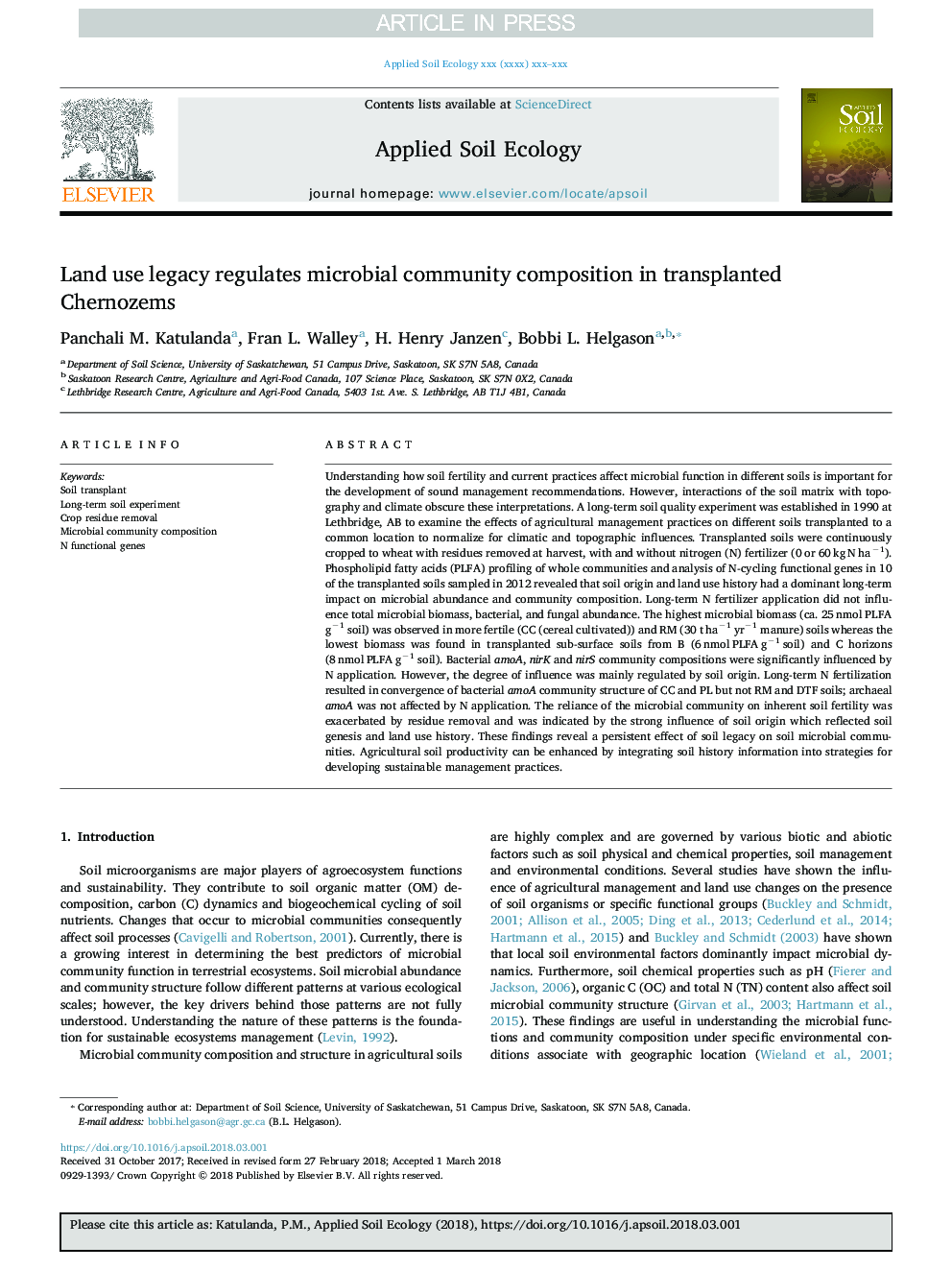| کد مقاله | کد نشریه | سال انتشار | مقاله انگلیسی | نسخه تمام متن |
|---|---|---|---|---|
| 8846589 | 1617754 | 2018 | 11 صفحه PDF | دانلود رایگان |
عنوان انگلیسی مقاله ISI
Land use legacy regulates microbial community composition in transplanted Chernozems
ترجمه فارسی عنوان
میراث استفاده از زمین، ترکیب جامعه میکروبی را در چرنوزم های پیوند خورده تنظیم می کند
دانلود مقاله + سفارش ترجمه
دانلود مقاله ISI انگلیسی
رایگان برای ایرانیان
کلمات کلیدی
پیوند خاک، تجربه طولانی مدت خاک، حذف بقایای محصول، ترکیب جامعه میکروبی، ژن های عملکردی،
موضوعات مرتبط
علوم زیستی و بیوفناوری
علوم کشاورزی و بیولوژیک
بوم شناسی، تکامل، رفتار و سامانه شناسی
چکیده انگلیسی
Understanding how soil fertility and current practices affect microbial function in different soils is important for the development of sound management recommendations. However, interactions of the soil matrix with topography and climate obscure these interpretations. A long-term soil quality experiment was established in 1990 at Lethbridge, AB to examine the effects of agricultural management practices on different soils transplanted to a common location to normalize for climatic and topographic influences. Transplanted soils were continuously cropped to wheat with residues removed at harvest, with and without nitrogen (N) fertilizer (0 or 60â¯kgâ¯Nâ¯haâ1). Phospholipid fatty acids (PLFA) profiling of whole communities and analysis of N-cycling functional genes in 10 of the transplanted soils sampled in 2012 revealed that soil origin and land use history had a dominant long-term impact on microbial abundance and community composition. Long-term N fertilizer application did not influence total microbial biomass, bacterial, and fungal abundance. The highest microbial biomass (ca. 25â¯nmol PLFA gâ1 soil) was observed in more fertile (CC (cereal cultivated)) and RM (30â¯tâ¯haâ1â¯yrâ1 manure) soils whereas the lowest biomass was found in transplanted sub-surface soils from B (6â¯nmolâ¯PLFAâ¯gâ1â¯soil) and C horizons (8â¯nmolâ¯PLFAâ¯gâ1 soil). Bacterial amoA, nirK and nirS community compositions were significantly influenced by N application. However, the degree of influence was mainly regulated by soil origin. Long-term N fertilization resulted in convergence of bacterial amoA community structure of CC and PL but not RM and DTF soils; archaeal amoA was not affected by N application. The reliance of the microbial community on inherent soil fertility was exacerbated by residue removal and was indicated by the strong influence of soil origin which reflected soil genesis and land use history. These findings reveal a persistent effect of soil legacy on soil microbial communities. Agricultural soil productivity can be enhanced by integrating soil history information into strategies for developing sustainable management practices.
ناشر
Database: Elsevier - ScienceDirect (ساینس دایرکت)
Journal: Applied Soil Ecology - Volume 129, August 2018, Pages 13-23
Journal: Applied Soil Ecology - Volume 129, August 2018, Pages 13-23
نویسندگان
Panchali M. Katulanda, Fran L. Walley, H. Henry Janzen, Bobbi L. Helgason,
